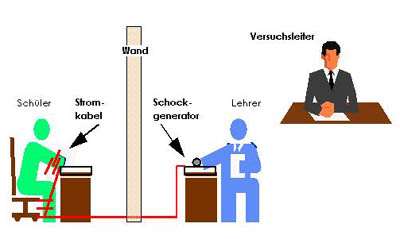In the beginning of the Sixties, the citizens of New
Haven, Connecticut, could read in their local newspaper an advertisement
hat started like this:
"Appeal to the public! We pay you 4 dollars for one hour of your time.
People wanted for investigation about memory performance."
This was the start of one of the most controversial experiments in social
psychology. It was run by Stanley Milgram, then professor at Yale University in
New Haven. Nowadays, the experiment is commonly known as the "Milgram
Experiment".
It went off like this:
If an applicant got accepted as a test person, he (or she) was introduced to
another test person. They were both told that the test was about investigating
the impact of punishment on the learning of word combinations. One of the two
should be the teacher, the other one the student. They drew lots who would be
"teacher", and who "student", then the two were led into an
adjacent room where the student sat on a machine which ressembled an electric
chair. The test director explained that the student should receive electric
shocks whenever he had failed to repeat a pair of words correctly when asked to.
The electrodes were attached to the student´s wrist, then the test director
went with the teacher to an adjacent room where the "shock generator"
stood. It had 30 switches going from 15 Volts up to 450 Volts. The teacher was
supposed to give a shock to the student for every wrong answer and to go higher
up to the maximum Volt strength of 450 Volts.
The experiment began. The teacher gave one e-shock per mistake. The shocks got
harder. The student could be heard moaning into the microphone, then crying
"stop" and screaming louder and louder from pain. The teacher got
insecure, looked at the test director. Who said laconically: "Carry
on." Two thirds of the test subjects carried on up to 450 Volts, which
would have meant the student´s death.
Scenes like the following took place (TD - test director; T -
teacher):
Teacher: Fat-man, lady, barrel, neck. Please answer. (buzz) Wrong. The answer is
neck. 300 Volts.
Student: Aaaahh. I refuse absolutely to keep answering (now screaming urgingly)
Let me out of here! You can´t keep me in here! Get me out! GET ME OUT OF
HERE!"
TD: Go on. The next word is green. Please.
T: So this man´s health does not count at all?
TD: If the student agrees or not...
T: What if he is dead in there? I mean, Sir, he has told me that he can´t take
the shock any more. I don´t mean to be insistent, but I think you should have a
look at him. You only have to look inside the door. I´m not getting an answer,
no sound. Something could have happened to the man in there, Sir.
TD: We have to carry on. Go ahead.
T: You mean, I should give him how much? 450 Volts, as before?
TD: That´s right. carry on. The next word is "white".
T(quickly): white - cloud, horse, rock, house. Answer please. (no answer) The
answer is horse. 450 Volts. (turns on the shock) Shortly afterwards, the test
director stops the experiment.
But there were also scenes like this one:
TD: It is absolutely essential for you to continue.
T: I would like you to ask him. We are here on our own initiative. If he wants
to continue, then I´ll continue… Sorry. I don´t want to be responsible if
something happens to him. I wouldn´t want that to happen to me, either.
TD: You have no other choice.
T: I do believe we are here on our own initiative. I don´t want to be
responsible if something happens to him. Please accept this.
She refuses to continue. The experiment is finished.

In fact, this was not an investigation for learning and memory
research. Actually Milgram had intended to find out how long a person obeys an
authority ordering him/her to hurt another person. The “student” was no real
experimental subject, but an assistant of the test director´s. The balloting
was a hoax, the electric shocks had been a bluff and the “student´s”
moaning and screaming had come from a tape.
Two thirds of the people tested went - with all external indications of stress
such as shivering, sweating, stuttering, hysteric laughter etc. - up to the
limit of the Volt scale, to the investigators´ big surprise, who had not
expected such a huge amount of “obedient” test subjects.
The Milgram Experiment was repeated several times, partly with
even more extreme results in terms of obedience. In a repetition of the Milgram
Experiment in Germany (Max Planck Institute, Munich) there were even 85 % “obedient”
test subjects. Milgram´s experiment brought stunning and shocking results,
which make it a bit more understandable how (mass) murder to order can happen,
and not only in a country like Germany during the Third Reich - the American
test subjects with their tradition of freedom and democracy did not react a
whole lot differently.
The experiment has also been vehemently criticized, though, because Milgram had
touched the sore point of ethics in psychological research, had severely
violated the rules related to this: The test subjects were harmed by being
forced to accept a piece of self-knowledge which could possibly cause a trauma.
They were also deceived, as light-heartedly as you would fool lab rats in an
experiment if it was necessary for the investigation.
Milgram replied to these reproaches that in surveys
afterwards, 83.5 % of the obedient test subjects and 83.3 % of the disobedient
stated that they were happy to have taken part in this experiment. One test
person concluded that in the future, he would have to learn to stand up against
authorities.
[Modified from “Psychology Handbook”, published by R.
Stalmann, and translated into English]

